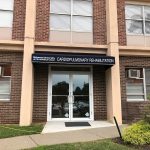Richmond University Medical Center’s comprehensive Rehabilitation Center offers a broad range of physical, occupational, and speech therapy for adult and pediatric patients who are dealing with everything from weakness in their extremities and cognitive issues to challenges with speech and swallowing, visual deficits, balance issues, developmental delays, and more. And recently, the Staten Island-based hospital was excited to add yet another offering to its extensive range of capabilities – an inviting new pediatric sensory gym designed to deliver a safe, therapeutic, and educational experience for babies and children.
Opened in the spring and located in a dedicated section of the Rehabilitation Center, “our new pediatric sensory gym is designed for babies as young as a few weeks old and/or just discharged from the NICU through school-age kids up through 7 or 8 years old,” shared Kristine Delgado, administrative director of rehabilitation at Richmond University Medical Center. “Because kids learn best when all of their senses are engaged, we created a safe, structured environment outfitted with specialized pieces of equipment designed to stimulate their senses, and kids love it because it’s really fun,” she said. “It’s like a little playground for them to enjoy while accomplishing a lot of therapeutic goals.”
Outfitted with soft foam floors and padded walls, Delgado said that the sensory gym is used for treating children diagnosed with everything from autism spectrum disorder, Down syndrome, and cerebral palsy to those with ADHD or a developmental delay involving their speech, gross or fine motor skills, muscle strength, balance/coordination, cognitive skills, or another faculty. “We can let them safely run in our enclosed space or jump on the trampoline while we work on some other skill,” she said. “It’s a fun, colorful, and natural environment for children and we find that they respond so positively and participate more.”
A Fun, Engaging Environment
Among other equipment, “our space features a sensory swing, a trampoline, a tunnel that kids can crawl through, a climbing wall, and a tabletop where they can work with kinetic sand, Play-Doh, water, and other textures to hone their fine motor skills,” Delgado said. “Our fun, engaging environment often brings out the best in each child versus a therapy session conducted in a more sterile office setting, and our one-way windows allow parents to view their child’s activity and progress without influencing or disrupting the child’s session in any way, which has elicited positive feedback from parents and therapists alike.”
According to Delgado, Richmond University Medical Center’s establishment of the sensory gym has been a proud accomplishment for the hospital and a major differentiator on Staten Island.
“We used to only treat adults in our Rehabilitation Center, but children now account for 35% of our patient population and it’s exciting to be able to offer them a safe, dedicated space rather than having to treat them in our adult gym and improvise,” she said. “Kids are progressing by leaps and bounds in their therapy now and our hospital’s pediatricians have been extremely proactive about identifying kids who have a need so that we can connect with them and their parents and pull them into our program.”

“Children can get therapy in a lot of places on Staten Island, but our pediatric sensory gym and comprehensive team of rehabilitation specialists are a package that kids can’t get anywhere else,” Delgado confirmed. “Parents tell us that they experience so much peace of mind knowing that their child’s therapy is being conducted in a safe, kid-friendly space that their child enjoys being in. In addition to inspiring children to greater heights, the fun setting also helps increase the likelihood that parents and children will come and be consistent with their therapy,” she said.
A Labor of Love
As the hospital’s entire Rehabilitation Center continues to expand in size and volume, Delgado believes that the sensory gym will follow suit.
“We’re hoping to grow the size of our pediatric sensory gym and add even more equipment in the future, but right now we just want to get the message out to the Staten Island community that our sensory gym is open and available to all children who can benefit from it,” said Delgado, who describes the design, construction, and introduction of the new space as a labor of love. “We’re an approved provider of rehabilitation services for the New York City Department of Education, so children in public school who can’t get therapy in school can now come here for therapy and experience our sensory gym. Few other providers in the area offer therapy in a setting like ours and our entire hospital team is extremely supportive of and invested in its success.”
“Overall, we want community members to benefit from all of the services we offer in our Rehabilitation Center, especially our new pediatric sensory gym,” Delgado concluded. “It helps connect all of the pieces for our pediatric patients and we look forward to building on it.”
Richmond University Medical Center is located at 355 Bard Ave. and can be reached at 844-934-CARE or by visiting www.rumcsi.org. Richmond University Medical Center’s comprehensive Rehabilitation Center is located at 288 Kissel Ave. (behind the main hospital building) in Staten Island. For more information, call 718-818-3163 or visit www.rumcsi.org/services/rehabilitation/.
Susan Bloom




